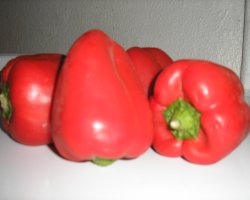
Photo by Jewel Kinilitan-Bissdorf
Pepper
Common name: Capsicum, chili pepper, hot pepper, cayenne, red pepper, Tabasco paprika pepper, sweet pepper, bell pepper, green pepper
Scientific name:
Capsicum annuum, C. frutescens
Family: Solanaceae
Weeds
Grasses
Sedges
Broadleaf
Diseases
Fungal
Bacterial
Viral
Agro-ecology
Planting hot cherry peppers as perimeter
trap crops reduces the maggot population on bell or sweet peppers. Pepper maggots, important pepper pests, prefer to infest the hot cherry peppers. Since pest control is concentrated on the trap crops, the main crops grown are usually left unsprayed. This practice preserves most of the
beneficial insects that help control aphids and corn borer eggs (Boucher, 2002). The maggot population increases due to the continuous
planting of members of nightshade crops in the same field. Practicing crop rotation or multiple cropping with other crops like beans, carrot, marigold, marjoram, onion, and tansy (Ellis; Bradley, 1996: pp. 173, 419-420) disrupts the life cycle of pests attacking nightshade crops and attracts natural enemies into the field crops' environment (Berke; et al., 2001).
Apply organic material fertilizers in both irrigated or rainfed conditions to improve plant growth and soil condition such as: Cow dung at 10-15 t/ha, poultry manure at 3-4 t/ha, and goat manure at 5-6 t/ha. Applications can be done either individually or combination depending on availability. Compost can be prepared in the field and applied before planting pepper at the rate of 5-10 t/ha (FADINAP, 2000: pp. 89-90). However, fertilizer recommendations based on soil analyses offer the very best chance of getting the right amount of fertilizer without over or under fertilizing. Ask for assistance from local agriculturist office.
n
Rice straw, Gliricidia leaves, and other plant residues can be placed in between rows in standing crops as mulch. Generally 5-8 t/ha dry basis and up to a thickness of 2-4 cm above ground is recommended (FADINAP, 2000: pp. 89-90). If you have access to fresh seaweed, rinse the seaweed to remove the salt when applying as mulch. Apply œ kg per100 sq feet area. Seaweed is a long-term soil conditioner and growth regulator. It contains micronutrients, amino acid and enzymes plus growth hormones that stimulate plant cell division (Card; Whiting; Wilson, 2002: pp. 7-8).
External links
References
- Berke, T.; et al. (2001): Sweet pepper production. Prepared by T. Kalb.
AVRDC. http://www.avrdc.org.tw/LC/pepper/swtprod/01title.html
- Boucher, T.J. (2002): Perimeter trap crop recommendations for pepper maggots. Integrated Pest Management. University of Connecticut.
- CABI. (2000): Crop protection compendium. Global module, 2nd edition. CABI Publishing, Wallingford, UK.
- Card, A.; Whiting, D.; Wilson, C. (2002): Organic fertilizers. Colorado Master Gardener Training. Colorado State University. CMG Fact Sheet #S-34.
- Nielsen, G. R. (1997): Pepper pests. Plant and Soil Science Department. University of Vermont, USA.
- Parker, B.; Talekar, N.; Skinner, M. (2000): Field guide: Insect pests of selected vegetables in tropical and subtropical Asia. AVRDC Publication.
- Wagner, Georg. (2004): Vegetables' pests. Personal Communication. Schopperplatz 14, 4082 Aschach / Donau.

